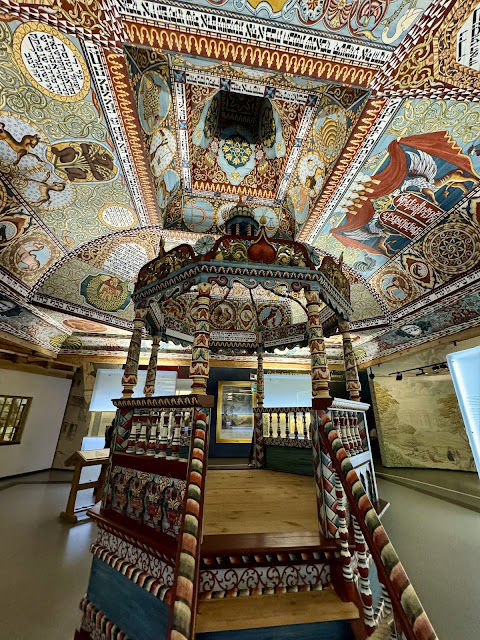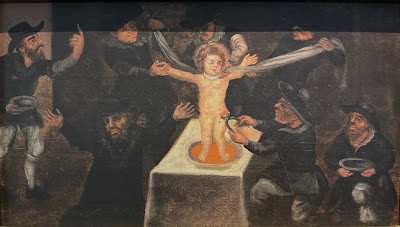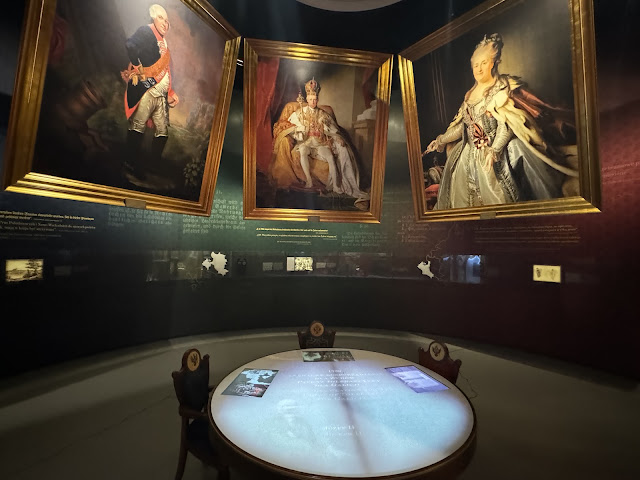A striking mezuzah hangs above the entrance to the POLIN Museum of the History of Polish Jews.
Designed by a Finnish architectural firm, it's located in the former neighborhood of the Warsaw ghetto, and opened in 2013 on the 70th anniversary of the uprising there.
Some say the huge external gash which continues inside the modernist building symbolizes the parting of the Red Sea by Moses, who led the Jews to the promised land.
The museum faces a monument honoring the Jewish resistance.
In Hebrew, "polin" means "rest here." The letters spelling the word in both Hebrew and Latin can be seen silkscreened on the glass and copper exterior of the building.
Exhibits divided into eight chronological sections examine Jewish life in Poland going back a thousand years when trade routes established in the Middle Ages first brought them into the area around Kraków.
Persecution of Jews in Western Europe persuaded them to settle there and later, Warsaw, when the Commonwealth of Poland and Lithuania, founded in 1569, was more welcoming. But they weren't allowed to live in the Baltic port city of Gdańsk, although public records indicated their trade was welcome.
A Polish language proverb circulated at the wedding of Sigismund III Vasa in 1605, declared "The Polish kingdom is: Paradise for the Jews, Hell for the peasants, Purgatory for the burghers, rule by Servants." Scholars have cited this both as evidence that the years from 1569 to 1648 were "Jewish paradise" in Poland, and as sarcasm indicative of the anti-semitic progroms to come.
The Cossacks were particularly brutal during the Khmelnytsky Uprising, and primarily recruited from the ranks of peasants in what is now Ukraine who resented Jewish leaseholders and merchants. By the time the conflict ended, the region tilted toward Russia, an early forecast of the commonwealth's partition a century later, after a long period of decline.
Once the progroms ended in 1657, Jewish life thrived in many Polish villages or shtetls as it had in areas where the Cossacks did not hold sway.
Temple, of course, was central to Jewish life. This beautiful reconstruction of an elaborate bimah and painted ceiling from the Gwoździec synagogue, made from wood in the 17th century, induces expressions of awe.
Nevertheless, anti semitism is never very far away. This painting depicts blood libel, a common trope.
It was a little surprising to see a portrait of an Revolutionary War hero, Tadeusz Kosciuszko, displayed but he fought hard to maintain the commonwealth's independence with less success than he had as a young military officer in America.
The failure of the Kościuszko Uprising in 1794 resulted in the Habsburg Empire, Prussia and Russia partitioning the commonwealth. Poland ceased to exist until after the end of World War I and the treatment of its Jews varied according to who ruled them politically.
Concurrently, the Jewish Enlightenment or Haskalah took place throughout central and eastern Europe, fathered by Moses Mendelssohn. The movement encouraged greater assimilation and reduced the influence of rabbis.
At the same time, it revived the use of Hebrew in secular life.
Jewish life urbanized to a large extent during the Industrial Revolution, due in part to better transportation networks and employment opportunities for both men and women in cities all over Poland.
Jews typically labored in small workshops, securing contract work from factories that mostly employed Christians because their owners did not want to cease operations on two different sabbaths.
Their temples got bigger. In the late 19th century, the Great Synagogue of Warsaw was the largest in the world. The Nazis destroyed it after the ghetto uprising as they already had done to the Gwoździec synagogue in what is now Ukraine.
From 1881 to 1914, 2.4 million Polish Jews emigrated to other countries, 85% of them to America. Most ended up in New York City's Lower East Side where they recreated "shtetl" life.
No doubt this enormous migration contributed to the ideas behind The Protocols of the Elders of Zion, one of the 20th century's most influential pieces of antisemitic literature. First published in Russia as a forged document, it supposedly revealed the Jewish conspiracy to dominate the world. Some people still believe its lies a century later, and the internet has given it a new currency among hate groups.
But the Jews who remained in Poland established a thriving culture, speaking and writing in Yiddish. Astonishingly, nearly 100,000 people attended the funeral of Yitskhok Leybush Peretz (in photo at left), an author and playwright. A champion of his people and a literary cheerleader for their self-determination, he bridged the gap between the Hasidim--who had ignored the reforms of the enlightenment--and the intelligentsia. Said Peretz: Without Hebrew, the folk have no past; without Yiddish, we have no folk. Asked the muses of art, literature and poetry in the drawing below: Who will replace him?
Jews were early adopters of a new art form, cinema, and produced their own movies in Poland after World War I, when its national borders were established for the first time in 123 years. The loyalties of some Jews, who lived closer to Russia and had supported the Bolshevik revolution, for example, remained conflicted and became easy targets for scapegoating when the Nazis invaded Poland.
Mostly minority parties competed for the Jewish vote (almost 10% of the population) in the national parliamentary elections of the Second Polish Republic. These elections produced unstable governments, eventually resulting in a 1926 coup d'etat by Marshal Józef Piłsudski who ruled Poland until the Nazi occupation. Many Jews considered him their last best hope against the tide of antisemitism that threatened them from Germany. He died in 1935.
Polish Jews also continued their migration between the two world wars, this time to Palestine as part of the Zionist movement. The British, who then controlled the territory, allowed 140,000 to enter. It became harder for them to do so during the 1930s with the escalation of conflicts between Jews and Arabs.
The Distenfeld family were among the lucky ones. They were admitted in 1933.
Christine and I had been among the first to enter the museum. Exhausted three hours later, with both the Holocaust and Post War sections to go, I paid less attention to these exhibits figuring I already had absorbed a lot of this history at the Museum of the Second World War, Oskar Schindler's Enamel Factory and Auschwitz. Still, several items caught my eye, including this ration card.
An organization chart for the group of Jews engaged in the liaison work between the Nazis and their community reflected a mostly reviled bureaucracy of individuals in denial about the occupiers' intentions. The strategy failed to protect themselves and their families.
A continuing exhibit juxtaposes the writings of Adam Czerniaków, who headed of Warsaw's Judenrat from 1939 to 1942, and Emanuel Ringelblum, who served as the archivist for the ghetto and took copious notes about what occurred there before the Gestapo murdered him in 1944. Fortunately, he successfully hid most of what he had written and gathered from other sources prior to his capture. Czerniaków killed himself with a cyanide pill after the Nazis began the mass deportation of Jews to Treblinka where they were robbed before being gassed. In his diary a year earlier he had written: I am reminded of a film: a ship is sinking and the captain, to raise the spirits of the passengers, orders the orchestra to play a jazz number. I had made up my mind to emulate the captain.
A post-war poster honoring the Jewish resistance linked the ghetto uprising with the ongoing fight for Israeli independence five years later and finally achieved on May 14, 1948.
More Poland
Gdansk:
Kraków:



































No comments:
Post a Comment